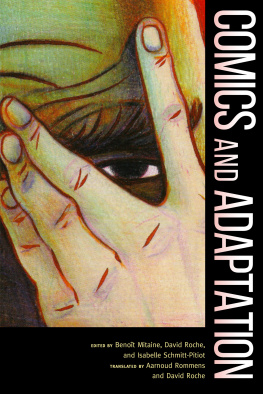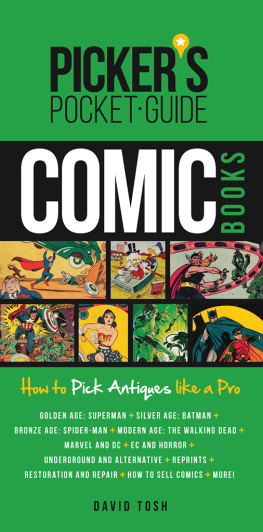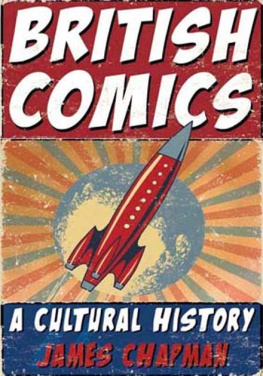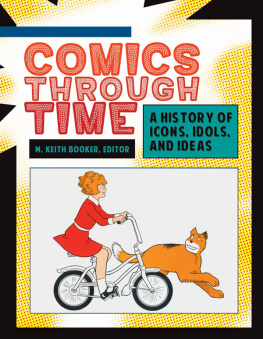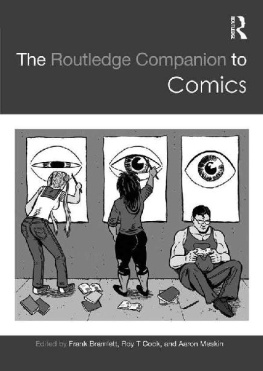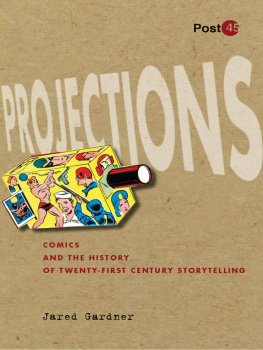Of Comics and Men
Of Comics and Men
A Cultural History of American Comic Books
Jean-Paul Gabilliet
Translated by
Bart Beaty and Nick Nguyen

www.upress.state.ms.us
The University Press of Mississippi is a member of the Association of American University Presses.
Originally published in 2005 by Editions du Temps as Des Comics et des hommes: Histoire culturelle des comic books aux tats-Unis. This edition is published by arrangement with Editions du Temps. Copyright 2010 Editions du Temps Translation and introduction copyright 2010 University Press of Mississippi
All rights reserved
Manufactured in the United States of America
First printing 2010
Library of Congress Cataloging-in-Publication Data
Gabilliet, Jean-Paul.
[Des Comics et des hommes. English]
Of comics and men : a cultural history of American comic books / Jean-Paul Gabilliet ; translated by Bart Beaty and Nick Nguyen.
p. cm.
Includes bibliographical references and index.
ISBN 978-1-60473-267-2 (cloth : alk. paper) 1. Comic books, strips, etc.United StatesHistory and criticism. I. Beaty, Bart. II. Nguyen, Nick. III. Title.
PN6725.G33 2010
741.5973dc22 2009025381
British Library Cataloging-in-Publication Data available
Contents
Translators Preface
One of the difficulties involved in translating Jean-Paul Gabilliets Of Comics and Men is that, as a history, it is so very current that even small changes in the American comic book field frequently called out for new analysis. When one works, as Gabilliet does here, with history that is so present, the ideal of comprehensiveness is almost impossible to achieve. It is a great testament to the author that this work feels as if its pages were just written, and that its conclusions shed light on the status of comics as they exist at this moment, and not merely in the past.
Originally published as Des Comics et des hommes: Histoire culturelle des comic books aux tats-Unis by ditions du temps in 2005, Of Comics and Men is the type of historical account that has been all too absent from American comics scholarship. The dominant trend in the historiography of American comic books, as Gabilliet observes in the bibliographic essay included at the end of this volume, has been toward books and magazines catering to an audience predominantly conceptualized as comic book fans. Rigorous scholarly work on the history of the comic book field has frequently been marginalized within publishing on the form. Perhaps it is fitting, therefore, that this important contribution to the history of the comics field has been penned by a scholar who himself is on the periphery of the world of American comics by virtue of the fact that he was raised and works in France, a nation with a very different comics past.
Gabilliet is a professor of North American Civilization at the Universit Michel de Montaigne Bordeaux 3 in Bordeaux, France. His interests are in cultural history of the United States and Canada in the nineteenth and twentieth centuries, with a particular focus on popular culture, including the history and aesthetics of comic books. As this book attests, he is exceptionally well-versed in the broad history of comic books, bringing to his scholarship the keen intensity of the fan and the cool critical interest of the scholar.
Unlike many chronicles of American comic books, Of Comics and Men is a blend of often disparate methodological strands. The first part is the most straightforward and familiar of the three sections, offering an overview of the development of the comic book in the United States. This section is broken down into nine chapters, each of which examines a span of comics history. Unlike many American comics scholars, who date the origin of comics from R. F. Outcaults The Yellow Kid in 1895, or from the development of the comic book format in the mid-1930s, Gabilliet traces the origins of the American comic book back much further to 1842. More importantly, he places the evolution of the comic book in relation to other comparable publishing formats, integrating the form much more thoroughly into the history of popular publishing in the United States.
The second section of the book focuses on producers and consumers, and offers a very different kind of history than can be found in other works on this subject. Gabilliet has not contented himself with merely enumerating various great men and great moments in the history of comic books, but has taken a much larger view that incorporates the structuring social and economic relationships that have largely defined the development of the field. By incorporating these important structuring elements, our understanding of the complex forces of social and aesthetic change within the field is greatly enhanced.
The final section of the book takes an important turn toward the sociological, deftly transitioning from the discussion of comics as a professional field toward the context of comics as a field of cultural production. Drawing on the influential work of Pierre Bourdieu, Gabilliet wonders why comics have attained so little legitimacy within the broader cultural domain. Here he turns his eye toward complex social relations. Using the lens of censorship debates from the 1940s through to the current period, he traces the development of public thinking about the comic book form. He also offers a compelling examination of the development of organized comics fandom, demonstrating better than any work to date the important structuring relationship that has existed between fans and the comics that they read, collect, and valorize.
Although he deals with ideas that are often complex, Gabilliets writing style is very approachable, and we hope that we have done some justice to it with our translation here. The most important issue facing us as translators of a volume such as this one was not the introduction of new concepts or terminology, but the fact that the book addresses itself to a moving target. Even as we were working on this book, for example, dramatic changes have influenced the comic book industry in the United States. The evolution toward a bookstore model of publishing and the important rise in popularity of manga have significantly impacted the shape of the industry in the past five years since the book was originally completed. The author has worked to address these issues in this edition of the book, updating it where appropriate and necessary. To this end, the book is not strictly faithful to the original edition of the text, but has been refined in light of more recent evidence and developments.
It is perhaps both ironic and fitting that a Frenchman should pen the first major scholarly overview of the development of the American comic book industry. We would suggest, however, that the authors status as an outsider within the often cliquish world of comic books is precisely the reason that this book makes such an important contribution to the burgeoning field of comics studies. Of Comics and Men is a timely book about the passage of time in this field, and one that will surely be consulted for years to come.
BART BEATY AND NICK NGUYEN
January 2009
Introduction
A Second-Rate Medium
Picking up the conclusions of an article published two months earlier in Harpers by its editor-in-chief Russell Lynes, the April 11, 1949, issue of the popular weekly Life offered its readers a large double-page chart representing cultural hierarchies in the United States. The chart was divided into eleven columns classifying individual preferences in areas such as clothes, furniture, entertainment, games, and even dietary habits, and it presented four levels of cultural consumption in American society, from the most elite to the most popular. The column devoted to reading preferences was laid out as follows: avant-garde literature and criticism was found at the highest level; just below, solid nonfiction, the better novels, quality magazines; the third echelon was for literature of the book club type and mass distribution magazines. At the bottom level there were two types of popular literature magazines printed on cheap paper: pulps and comic books.
Next page



